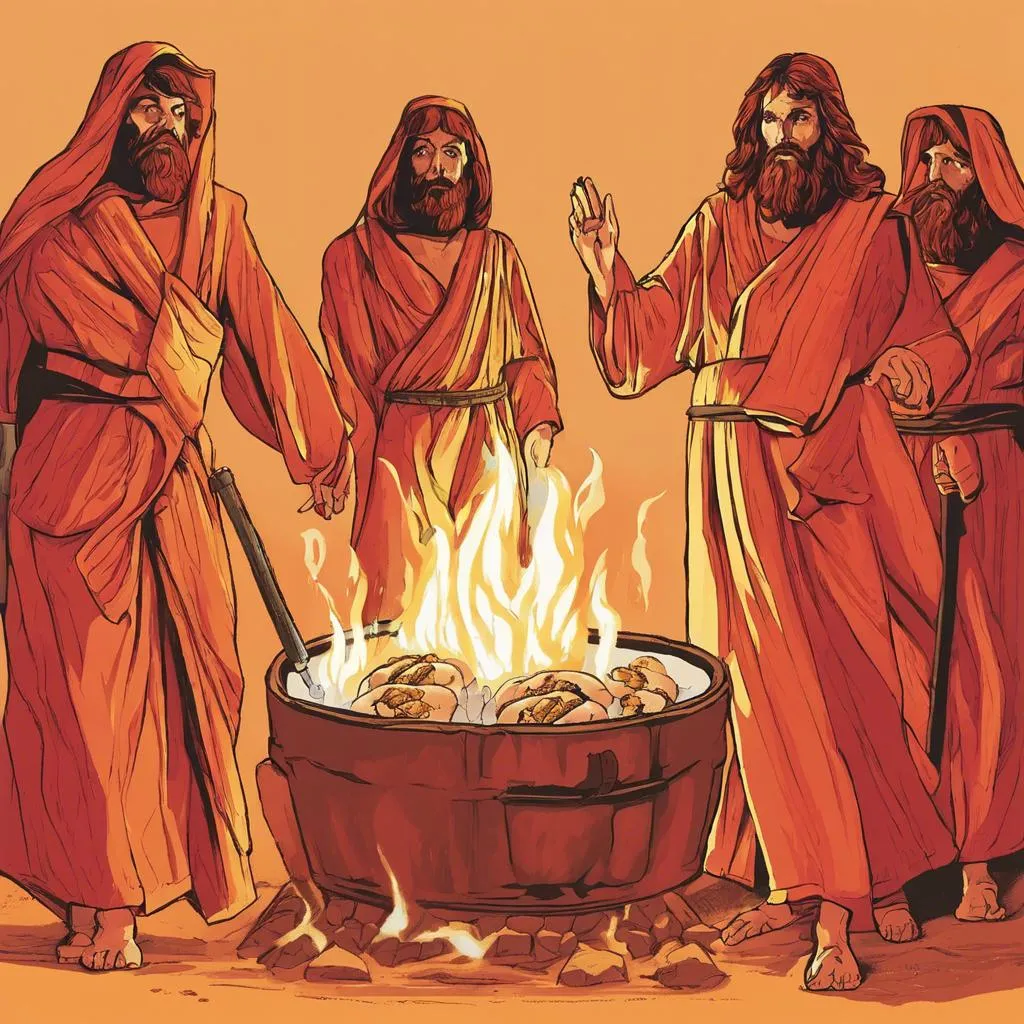WELCOME!
Thank you for contributing to biblical research!
Dive into a world of captivating narratives that transport you to a deeper understanding of the Lord, Jesus Christ. Learning about Christ involves biblical, theological, and practical research; these are essential areas for believers to study to grow in spiritual maturity.

Narrative and Apocalyptic Genres in Daniel
Have you ever been in an intensely confusing situation where you couldn't understand what was happening? Then, a friend shares a truth regarding the circumstance, which brings everything into focus. I certainly have. This is like understanding the book of Daniel. Today, the Bible has been completed, encompassing a wide range of genres. In fact, the prophet Daniel’s material consists of two distinct genres: narrative and apocalyptic. This study will discuss the implications of the four beasts in Daniel 2 and 7, utilizing narrative and apocalyptic genres. They are significant in deciphering the Book of Daniel. As readers and scholars, you play a crucial role in this process. Your understanding of the passages, the mixture of genres, and the text considering the whole is vital in unraveling the mysteries of Daniel.
Understanding the Passages
The first point is that narrative and apocalyptic genres are significant to deciphering the book of Daniel. Understanding the passages is crucial in this process. The first scripture to grasp is the narrative passage in which the king had a dream (Dan. 2:1).[1] This is important as throughout the book of Daniel, King Nebuchadnezzar had only one more dream following this chapter (Dan. 4:5). In fact, the king was very shocked because the dream was as if his spirit was being tried on an anvil.[2] A suggestive interpretative element is that this vision challenged King Nebuchadnezzar, as this communication format was culturally recognized as a memorandum from the gods.[3] From this point, the king gathered magicians, enchanters, sorcerers, and the Chaldeans to tell him the dream. They asked if the king could describe the vision (Dan. 2:2-4). The king denied their request and exclaimed that they would be torn limb from limb if they did not tell the dream and its interpretation. However, if they obey him, the monarch will grant them honor and rewards (Dan. 2:5-6). The wise men asked again, and Nebuchadnezzar stood firm to his word. Thinking they were stalling, he mentions they would agree to speak corrupt words (Dan. 2:7-9). Furthermore, he was testing them to interpret this vision.[4] They could not explain the dream unless the gods appeared in the flesh. Such as when the One True God, Jesus Christ, appeared in the flesh. So, the king made a decree to kill these gifted men. Daniel hears about this matter and consults with the captain of the guard about the issue, eventually arranging a time to present the emperor with the interpretation of his dream (Dan. 2:10-16). Daniel then explains the problem to his companions, who pray to God (Dan. 2:17-18). The Lord reveals the mystery of the dream to Daniel, praises the Lord, travels to Arioch, and goes before the sultan (Dan. 2:19-24). Daniel explains to Nebuchadnezzar that only God can interpret the vision, continuing to say that a statue was filled with gold, silver, bronze, iron, and iron mixed with clay (Dan. 2:25-33). No human hands cut a stone, and the statue was broken, like chaff, and the rock became a great mountain over the earth (Dan. 2:34-35). The interpretation is that King Nebuchadnezzar’s kingdom is great, yet it will fall to other countries. They will decline, and God will set up a kingdom that will never be destroyed (Dan. 2:36-45). Afterward, Daniel is promoted for interpreting the king's dream. He made Daniel a leader of the province of Babylon and gave him authority over the wise men. Daniel requested that his companions have jurisdiction over the affairs in the province, and Daniel remained at the king’s court (Dan. 2:46-49). The interpretive element of this narrative passage is that the characters, setting, and plot are relatable to everyday life and are interpreted literally. The apocalyptic passage, which employs symbolic language, will still conclude with a literal interpretation of scripture.
Understanding the Apocalyptic Passage
Moving to chapter seven, this passage details Daniel’s vision of the four beasts. The scripture begins in the first year of Belshazzar, king of Babylon, during which Daniel wrote the dream and explained the matter (Dan. 7:1). The first segment he saw in the dream contained the four winds which were arousing the sea, and then suddenly four beasts came out of the ocean (Dan. 7:2-3). Stephen Miller, author of Daniel in the New American Commentary, describes the meanings of these four beas:s, “Adherents of the traditional view of Daniel almost unanimously agree that the kingdoms are Babylon, Medo-Persia, Greece, and Rome; whereas those who accept the Maccabean thesis usually consider the four empires to be Babylon, Media, Persia, and Greece.”[5] These beasts, described differently from one another, are similar to the statue mentioned previously (Dan. 2:31-45). Except for one minor detail, there were ten of them, and a little horn rose from around where three of the horns were plucked by the root (Dan. 7:7-8). This little horn is portrayed as having the eyes of a man and a mouth that speaks great things (Dan. 7:8). Miller further describes this discourse as a poetic parallelism in contrast to the Antichrist and the Ancient of Days.[6] Daniel perceives the Lord’s glory; then, the beast is killed. The remaining animals were taken away and remained for a season (Dan. 7:9-12). As Daniel sees the night vision, the Son of Man is given dominion so that everybody will serve Him (Dan. 7:13-14). Furthermore, as Daniel was anxious in his spirit, he approached a person who stood there and explained the interpretation of what he saw (Dan. 7:15-16). This person explains to him that the four beasts represent kings, yet the saints of the Lord will receive the kingdom forever. Daniel becomes curious about the fourth beast (Dan. 7:17-22). He further mentioned that this animal is the fourth kingdom in which ten kings will rise after it falls. Then, the little horn will also increase as a unique king and destroy three of the previously mentioned ten kings (Dan. 7:23-24). Furthermore, he will blaspheme against God and war against the saints. His dominion will be taken away and given to the saints, where the Lord’s kingdom is everlasting (Dan. 7:25-27). Daniel was troubled by the dream to the point that he even changed his color. Yet, he kept the matter to himself (Dan. 7:28). Miller describes the criteria for biblical apocalyptic genres as the writer’s physical perception of the prophecy, symbolism, and not adding secondary meaning to the prophecy.[7] Therefore, the interpretative element in this apocalyptic passage is played out when Daniel perceives the vision given to him by the Lord, including the symbolism of the beasts and horns, and the Ancient of Days bestowing dominion over everything on Jesus Christ. The following section examines the combination of narrative and apocalyptic literature in Daniel's overall presentation.
The Mixture of Genres
The second point is that narrative and apocalyptic genres are significant in deciphering the book of Daniel by understanding the mixture of genres. The Harvest Handbook of Bible Prophecy provides the implication of defining apocalyptic literature, “…these interpreters mean that these books unveil or disclose God’s future prophetic program. The Greek word apokalypsis means to unveil or disclose.”[8] These authors explain that this type of literature is sometimes categorized alongside extrabiblical writings, which flourished during the intertestamental period.[9] These two chapters of scripture unveil or disclose visions to different people, one to King Nebuchadnezzar and another to Daniel (Dan. 2:1, 7:1). A noticeable pattern is that both genres required the dreams to be interpreted (Dan. 2:2, 7:16). The combination of these genres not only present a robust story, but they also contribute to the overall message of Daniel through the running themes. For instance, Daniel's chapter two discusses the implications of the statute. In contrast, Chapter 7 describes the four beasts, all of which are symbolized constructs that relate to each other as scripture interprets scripture.[10] These two genres present running themes and contribute to the Book of Daniel through the reality of a Jewish captive in Babylon and the interpretive future of the kingdom of God. These classifications portray a picture of the message in Daniel by describing the physically unveiled reality. The final section examines how these two chapters contribute to Daniel's overall message.
Chapters in Light of Daniel
The third point is that narrative and apocalyptic genres are significant in deciphering the book of Daniel by understanding the text in light of the whole. Throughout this study, it has been noted that these two chapters reference parallel meanings. These passages serve as the starting point of Daniel's prophecy, which is later expanded upon in chapters eight through twelve. Miller correlates this imagery with the different parts of the statue to the four beasts it represents.[11] These chapters conclude with the everlasting kingdom of God (Dan. 2:44, 7:27). Daniel’s vision delves more in-depth into the concept of the ten kingdoms and the antichrist (Dan. 7:7-8, 20-26).[12] Miller further describes the connections to the antichrist: “The picture of this evil, future king in these verses concurs with descriptions of him found in other Scripture passages (cf. Dan 11:36–37; 2 Thess 2:3–12; Rev 13:5–6).”[13] Furthermore, these chapters reflect the coming revelation of Jesus Christ. The Harvest Handbook of Bible Prophecy explains that in Daniel 7, the future fifth kingdom is symbolized as the stone that destroys the statue representing the earthly kingdoms (Christ’s kingdom; Dan. 2:34, 45).[14] The visions of the statue, beasts, winds, horns, the Ancient of Days, and the Son of Man shape the overall message in the Book of Daniel through the unveiling of prophecy to a king and a prophet.
Conclusion
In conclusion, narrative and apocalyptic genres are significant in deciphering the Book of Daniel, as understanding the passages, the mixture of genres, and the text as a whole is crucial. By grasping these concepts, the overall message of Daniel is as clear as glass. My call to action is to examine narrative and apocalyptic genres throughout the Bible, providing further clarity when studying prophetic literature.
Bibliography
Couch, Mal. “Daniel, Eschatology Of.” In The Harvest Handbook of Bible Prophecy, Edited by Ed Hindson, Mark Hitchcock, and Tim LaHaye, 79-83. Eugene, OR: Harvest House Publishers, 2020.
Miller, Stephen R. Daniel. Vol. 18. The New American Commentary. Nashville: Broadman &Holman Publishers, 1994.
Pentecost, J. Dwight. “Daniel.” In The Bible Knowledge Commentary: An Exposition of theScriptures, edited by J. F. Walvoord and R. B. Zuck, 1323-1375. Wheaton, IL: Victor Books, 1985.
Rydelnik, Michael. “Daniel.” In The Moody Bible Commentary, eds. Michael Vanlaningham,2063-2119. Chicago: Moody Publishers, 2014. Accessed November 5, 2021. ProQuest Ebook Central.
Woods, Andy. “Apocalypticism.” In The Harvest Handbook of Bible Prophecy, Edited by EdHindson, Mark Hitchcock, and Tim LaHaye, 39-43. Eugene, OR: Harvest House Publishers, 2020.
[1] Unless otherwise noted, all scripture referenced is in the English Standard Version.
[2] Stephen R. Miller, Daniel, vol. 18, The New American Commentary (Nashville: Broadman & Holman Publishers, 1994), 77.
[3] Ibid., 78.
[4] J. Dwight Pentecost, “Daniel,” in The Bible Knowledge Commentary: An Exposition of the Scriptures, ed. J. F. Walvoord and R. B. Zuck, vol. 1 (Wheaton, IL: Victor Books, 1985), 1333.
5 Miller, 196.
[6] Miller, 204.
[7] Miller, 193.
[8] Andy Woods, “Apocalypticism,” ed. Ed Hindson, Mark Hitchcock, and Tim LaHaye, The Harvest Handbook of Bible Prophecy (Eugene, OR: Harvest House Publishers, 2020), 39.
[9] Ibid.
[10] Rydelnik, Michael, and Vanlaningham, Michael, eds. The Moody Bible Commentary (Chicago: Moody Publishers, 2014), 2091. Accessed November 5, 2021. ProQuest Ebook Central.
[11] Miller, 196.
[12] Ibid.
[13] Miller, 202.
[14] Mal Couch, “Daniel, Eschatology Of,” ed. Ed Hindson, Mark Hitchcock, and Tim LaHaye, The Harvest Handbook of Bible Prophecy (Eugene, OR: Harvest House Publishers, 2020), 83.

